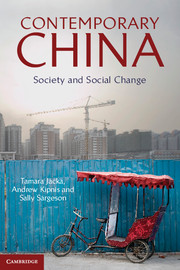Book contents
- Frontmatter
- Contents
- List of Images
- List of Maps
- List of Figures
- List of Tables
- Acknowledgments
- List of Abbreviations
- Map 0.1: China's provinces and provincial capitals
- Introduction
- Part 1 Social Institutions
- 1 Families, Kinship and Relatedness
- 2 Marriage, Intimacy and Sex
- 3 Citizenship, Household Registration and Migration
- 4 Community Institutions
- 5 Work
- Part 2 Cultures, Socialization and the Formation of Identities
- Part 3 Inequalities, Injustices and Social Responses
- Glossary of Chinese Terms
- References
- Index
1 - Families, Kinship and Relatedness
Published online by Cambridge University Press: 05 June 2014
- Frontmatter
- Contents
- List of Images
- List of Maps
- List of Figures
- List of Tables
- Acknowledgments
- List of Abbreviations
- Map 0.1: China's provinces and provincial capitals
- Introduction
- Part 1 Social Institutions
- 1 Families, Kinship and Relatedness
- 2 Marriage, Intimacy and Sex
- 3 Citizenship, Household Registration and Migration
- 4 Community Institutions
- 5 Work
- Part 2 Cultures, Socialization and the Formation of Identities
- Part 3 Inequalities, Injustices and Social Responses
- Glossary of Chinese Terms
- References
- Index
Summary
The family is a basic social institution and unit of human organization around the world. Families nurture children as they grow into adults and learn, enact and sometimes resist norms of human behavior. Families are also among the sites where the affective aspects of human interaction are most intimately learned and most deeply felt. In all societies, though, there are gaps between the family as an institution, and actual families and family relationships, and ideals and practices vary among population subgroups and over time. In this chapter, we explain the main elements of the dominant institutions of kinship and family as they pertained in imperial China, and then look at how kinship norms were, and continue to be, extended to non-kin relationships and social interactions. We discuss some of the divergences between dominant family and kinship institutions and the realities of Chinese families, particularly in the late Qing dynasty of the late 19th and early 20th centuries. and explore the different ways in which Chinese family practices and understandings of what the family is and should be have varied among population subgroups. Finally, we examine how kinship and family institutions and practices have changed during the modern period, that is, since the late 19th century, and investigate the causes of those changes.
The model family: patrilineal kinship and virilocal marriage
Anthropologists describe dominant Chinese kinship patterns as patrilineal (meaning that descent is traced through the male line) and patriarchal (men have power over women, and the aged over the young); and marriages as virilocal or patrilocal (when women marry, they leave their natal family and the village in which they were born and move to their husband's home in another village).
- Type
- Chapter
- Information
- Contemporary ChinaSociety and Social Change, pp. 27 - 46Publisher: Cambridge University PressPrint publication year: 2013



